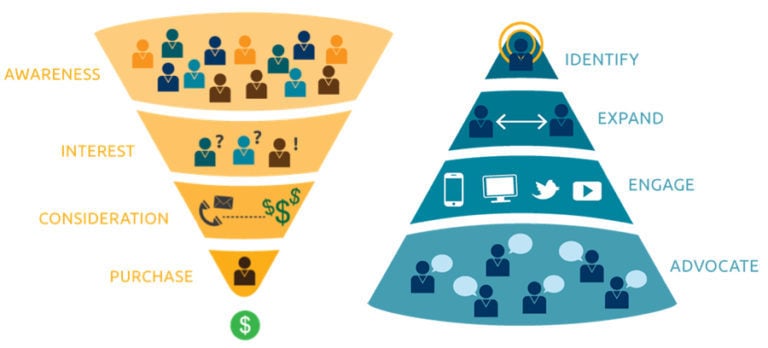Complete Guide to Account-Based Marketing (ABM) Setup

You’ve heard the buzz, you’ve had it with your pain points, and you’re thinking it might be time to hit the ground running with an ABM program.
Perhaps sales and inbound marketing have been stagnating and competitors are stealing market share, or you’re simply looking for a new marketing tactics playbook to take growth to the next level; all B2B companies decide to make the switch to this framework a bit differently.
Reasons for starting aside, the Account-Based Marketing (ABM) approach has steadily gained popularity across industries over the past decade for B2B marketers, and this approach is quickly becoming the norm rather than a nice-to-have for businesses looking to maximize the efficiency and efficacy of their marketing efforts.
Whatever the case, the ABM approach is fairly different from a standard demand gen-oriented approach to marketing. It requires a strategic plan, the right metrics measurement mechanisms, the right technology, an ideal customer profile, and the right resources to execute properly.
Integrating an account-based marketing framework into existing team-wide marketing and sales efforts can take some time and patience, alongside consistent action. This guide will serve as a good starting point to familiarize yourself with the methodology, the process, and what’s needed to get started.
At its core, account-based marketing is an outreach approach in which, unlike in traditional lead generation, marketing efforts are aligned around a selected list of high-value target accounts, and more specifically, the key decision-makers that will decide to go with your product or service.
If you google an ABM funnel, you will see several “flipped funnel” examples like the one below in which the traditional demand gen funnel has been flipped. This is the best way to visualize the difference strategically.

Source: B2B News Network - Account-Based Marketing: Flipping the Funnel
While demand generation is about casting a wide net to bring in many targeted prospects, account-based marketing involves working closely with the sales team to define a smaller group of target accounts. The sales team then devises a highly personalized marketing strategy to engage potential customer buyer personas within those specific accounts to get them to take desired actions, work to meet their needs, drive them to cross-sell and up-sell opportunities, and ultimately encourage advocacy.
Traditional B2B marketing efforts are focused on bringing in leads and closing deals but tend to neglect the post-sale process and expansion opportunities. As noted above, this is where ABM comes in.
In reality, good salespeople have long been giving attention to identified high-value accounts with a higher ROI potential to ensure client satisfaction, expand upon what they’re purchasing, and encourage referrals. An ABM approach involves using modern technology to bring the marketing team into these individual accounts, during the traditionally sales-dominated funnel stages.
Thinking about the scope of what’s possible with a sales team alone, and considering that multiple individuals at an account are often involved in making a decision, the ability to grow accounts with a sales team alone is limiting.
The account-based marketing play comes in when you consider that marketing can fill the gaps by extending the conversation to more stakeholders within an account, including more touchpoints across several online and offline channels. This leads to quicker sales velocity, greater overall return on investment, frequent purchasing, and the kind of customer satisfaction that leads to customer evangelism.
Account-based marketing will not serve to replace demand generation efforts. Instead, it can complement your evolving efforts by focusing more on the lower end of the funnel, which, in the end, contributes to and informs what you’re doing from a demand generation perspective.
At this point, you’ve officially decided to take the plunge and are ready to get started. As with many other processes inside and outside of marketing, the first step is to create a plan. Before you can begin building out an ABM strategy, you’re going to need to be sure that you have the right technology in place and set up properly.
Please keep in mind that, although tools and gadgets are fun, they can sometimes do more harm than good for your ABM efforts. It’s better to start lean and gradually add tools to your arsenal than to dive in head-first and kick off your program with a slew of tools you’ll only use occasionally. Remember, longevity is a key component to a successful ABM plan, and if you don’t have the financial resources to sustain your toolset for an extended period of time, it might be wise to reconsider your purchasing strategy. So, without further ado, let’s examine the different offerings available on the market today.
Here is a basic checklist of things you’re going to want to ensure you have in place to get started:
- A tool to identify specific companies that are visiting your website. Examples include:
- Leadfeeder - a great budget option for most of the basic functions.
- ClearBit - the middle ground, providing most features found in more robust solutions at a middle-price.
- Demand Base or Terminus - these are the titans in the space and provide the most functionality, though naturally, they also come with the highest price tag and the greatest resource requirements to get them set up correctly. It’s also important to note that they come with many additional functions that other platforms in your existing tech stack may already provide.
- A CRM and marketing automation platform that can serve as the single source of truth for all account data, allowing everything from an account perspective and all marketing campaigns executed to stem from one place.
- A closed-loop analytics tracking system, complete with things like UTM code, that will allow you to track KPIs for certain campaigns, tactics, and target account lists.
- Beyond email, a means of delivering ads not only to a specific list of contacts but further to a specified list of accounts.
- LinkedIn Ads - allows for the targeting of all contacts at an account via an upload of a list of target accounts and their associated data. Note that many CRM platforms have integrations that allow for automated transfer of account data to create an audience.
- Listenloop and other similar ABM-focused programmatic display ad platforms.
As you’re going through this setup, making sure you have the right marketing technology and that everything is set up correctly, you’re also going to want to conduct an audit of what marketing is already being done throughout the sales cycle. Your audit should focus on questions including, but not limited to:
- Generally, what types of accounts seem to respond best to the product your organization offers?
- What sub-segment of your market is prime for targeting, given your macro and micro environment's current state? That is to say, at both a large and a small scale, what things are going on in the market right now that would make a certain segment ripe for targeting with one of your products or services?
- What marketing channels have been successful, and what trends are you noticing when it comes to successful tactics with certain accounts?
All of these questions are geared towards getting you into the first real step of the ABM process: drawing up a strategy for your key accounts to develop a pilot for your initial targeting.
It’s important you take a fair amount of time sorting through the remaining ABM tools you’ll need to add to your strategy, but know that there’s a fine line between harnessing the robust functionality of these tools and bleeding your program dry. Routine research and plan reevaluation will help you ensure your team can accomplish goals and properly finance your ABM campaign as you go. Account-Based Marketing isn't a short-term initiative. It’s a process that requires fostering to actualize the goals you’ve set for yourself.
If you’re struggling with figuring out which accounts to target, or in a broader sense, which elements to focus on when determining which accounts to target, then predictive tools could be for you. Predictive tools include platforms such as Everstring, Leadspace, Infer, Radius, and Lattice, all of which help you develop your ideal account profile(s). They do this by finding patterns in your existing customer data and CRM while simultaneously comparing it to aggregated external data from both their integrations and publicly available sources. The result is a pattern that can then be mapped to new prospects to determine if they align with you and your strategy.
 Maybe you already have a list of ideal targeted accounts but are instead struggling to align your product/service offering with their strategic priorities and interests. In this case, ABM tools that focus on buyer intent might help. Some examples include Bombora, Capterra, and G2. Everstring makes another appearance here since it also has intent capabilities. Buyer intent tools track activity across the internet to identify the first moment of interest in your company, which is most often when accounts research topics relevant to your product or service offering.
Maybe you already have a list of ideal targeted accounts but are instead struggling to align your product/service offering with their strategic priorities and interests. In this case, ABM tools that focus on buyer intent might help. Some examples include Bombora, Capterra, and G2. Everstring makes another appearance here since it also has intent capabilities. Buyer intent tools track activity across the internet to identify the first moment of interest in your company, which is most often when accounts research topics relevant to your product or service offering.
If you’ve identified your accounts and their intent, the next set of tools that you could find utility in using are website personalization tools. Website personalization tools simplify and expedite personalized website experiences for your different accounts. These tools give you the capability to deliver a unique experience based on industry, organization size, and more. Demandbase, Jabmo, Optimizely, and Hyperise are a few examples. Google Optimize is also an option if your ABM strategy utilizes Google Analytics and you want to further build upon it.
Once it comes time to deliver content to your accounts, you can adopt some enhanced content delivery tools to customize your user’s website experience. These tools provide intelligent and dynamically-updated recommendations about what to read and/or view next based on prior activity. Some content delivery tools include PathFactory, SimpleReach, and Uberflip. Buffer is also an option to manage and optimize your content on social media channels.
One of the most important tools in your ABM toolkit, of course, is measurement. Some tools can help you measure incredibly robust data and tools that can simplify datasets so you can quickly analyze and move forward. If you’re looking for what will work for you and your team, as well as how to build a case for upper management approval, then some measurement tools like Bizible, Brightfunnel, Engagio, and Terminus are great tools to check out first.
Perhaps you want to take your ABM strategy offline and do things the old-fashioned way. Whether this is printed content messaging, direct mail, gifts, letters, or any other physical asset, offline content delivery can be hard to manage. Scaling and measuring a digital tactic is one thing, but trying to do the same with tangible content can be overwhelming and quite hard to automate. Tools like Sendoso and PFL are great ways to not only execute a tactic with physical assets but also to align them with the other elements of your overall ABM strategy.
Lastly, personalized video is a hot topic nowadays, and rightfully so. It’s an amazing opportunity to cut through the noise and connect with your accounts on a personal level. If you’re looking for personalized video tools, SundaySky, Idomoo, and Vidyard are all good options.
In this section, we’ll be discussing the steps and some strategies for ensuring your ABM program is sufficiently tested and planned before the official launch. It cannot be stressed how important this is. This information will help you get most of the way, but it is highly recommended that you pool your organizational knowledge and outside resources to make sure that your objectives and pilot are set up effectively.
The first step in a successful ABM strategy is determining your objectives. Some marketers tend to rush this step, which is a critical mistake. Your ABM objectives will spearhead your entire program, and misalignment or poor quality objectives will waste your time and ruin your plan in the long-term. It’s important to realize that it will take significantly more time and energy to fix your objectives when your program is operating than making sure you get them right in the first place. Although we’ve been mentioning ‘objectives’, there’s no rule that says you can’t have only one. It’s entirely situational and can be anything from improving the velocity of your existing pipeline to improving close rate, or even increasing deal size, expanding business, improving retention, and more.
After you have a solid grasp of your ABM objectives, you can start planning and building your pilot. A pilot is a crucial component to ABM because it:
- Provides you with a low-risk sandbox to play with when developing your ABM strategy
- Gives you further clarity and alignment on your objectives
- Secures executive and sales team alignment
- Ensures you don’t take your foot off the gas on your current demand generation programs due to overcommitment
The key here is to build trust in your program amongst all stakeholders while identifying inefficiencies and problems that you can fix to prepare for scaling your pilot. The most important pilot objective, above all else, is to maximize learning while simultaneously minimizing risk. This will continually build everyone’s confidence in your ABM strategy, which is very important for success.
Building a pilot affords the ABM team a solid level of flexibility and creative discretion. However, this flexibility isn’t something that can come from assumptions and feel. Instead, we have to base our decisions on concrete findings and, ultimately, numbers. The first example of this appears immediately: how big should the pilot be? We’ve already discussed that a pilot should be large enough to emulate how your official program will perform in the field while also being small enough to prevent executive panic and lay-offs. Although it’s not an exact science, we can get a good starting point by conducting some pilot math.
Start by getting a solid estimate of what one ‘win’ looks like to your organization. Is a win $50,000? Maybe it’s $1 million? Keep in mind that this should be a realistic figure that’s a good but attainable win. Let’s assume, for the sake of example, that your organization’s win is $100,000. Next, determine what your organization’s estimated win rate is. In our example, what percentage of $100,000 deals close, on average? Again, for the sake of example (and easy math), let’s assume that your win rate is 10%. Finally, we have to figure out what an ideal ‘pilot win’ will look like. How many wins do you need to consider the pilot a success? This will vary widely from company to company and will require some soul-searching. Talk to your sales and marketing teams, executives, and finance department to land on a realistic figure.
Don’t cut corners here, as this will greatly skew your results and could fail your pilot from the start. Be honest with yourself! Maybe after discussion, you settled on a ‘pilot win’ being 10 deals closed. Now it’s time for some math: 10 wins at $100,000 apiece means your pilot needs to bring in $1 million for a win. If you’re assuming a win rate of 10%, then you’ll need 100 accounts to hit your goal (10/(10%)=100).
Now that we have a plan in place, it’s time to build the pilot. When it comes to building a solid ABM program and, in this case, a pilot, think in terms of plays. Each play is an actionable item that creates a touchpoint with your accounts.
After you have a finished pilot, it’s time to bring it to market and start gathering data. Steve Watt talks about an interesting phenomenon called the ABM Hype Cycle - essentially an ABM Honeymoon Phase - which follows this launch. Solidifying your strategy and getting the program launched is an exciting milestone for your marketing team, but of course, your journey has only just begun.
There are key decision-makers on your sales and executive teams that expect your Account-Based Marketing strategy to be profitable and successful, and now it’s time to deliver. Setting proper expectations for what this success looks like will get you quite far, and doing so with regular performance updates will get you even further. ABM in any capacity is not a guaranteed success, and chances are that you will have reporting periods with less-than-satisfactory results. The best thing you can do is establish checks, testing, processes, and strong foundations from the onset that will provide longevity for your marketing campaigns.
Whether you’re in the planning phases of a new Account-Based Marketing strategy or seeing the data come in after a few months and getting a little worried, O8 can help make ABM work for your business. We are modern digital marketers, as well as website developers and website designers, with a unique service model that allows us to integrate and serve as an extension of your in-house team. Contact us or call today at 612-276-5880 if you’re ready to take your ABM strategy to the next level.

